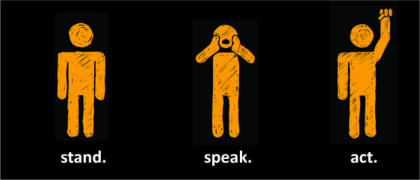
Bystander intervention is an increasingly common approach in violence prevention efforts. In this XY collection, I have compiled accessible resources on bystander intervention. See below for full-text materials. Tabachnik's piece is a particularly useful, accessible introduction. And I detail practical actions men (and women) can take on pp. 13-19 of this report, Men Speak Up.
- Flood, Michael. (2011). Men Speak Up: A toolkit for action in men’s daily lives. Sydney: White Ribbon Prevention Research Series, No. 4.
- McDonald, P., and M. Flood. (2012). Encourage. Support. Act! Bystander Approaches to Sexual Harassment in the Workplace. Sydney: Human Rights Commission.
- ACON (2018). Bystander Intervention Toolkit. Sydney: ACON.
- Bystander-Focused Prevention of Sexual Violence Outline
- Flood, M. (2015). Bystanders, sexual harassment, and building gender equality at work. Engaging passive bystanders in masculine work enviroments. Diversity Council of Australia Gender Reporting Network, Clayton Utz, Melbourne, May 18.
- Partners in Social Change. (2010). Bystanders: Agents in primary prevention. XIV(1), Winter (Washington, D.C.: Sexual Assault Prevention Resource Center).
- New York State Department of Health. (2013). Stop Sexual Violence - A Sexual Violence Bystander Intervention Toolkit. New York: New York State Department of Health.
- Tabachnick, J. (2009). Engaging Bystanders in Sexual Violence Prevention. National Sexual Violence Resource Center: Pennsylvannia.
- Katz, MVP Trainers' Guide for Male High School Students
- Katz, MVP Playbook for Female High School students
Also see:
- This collection of materials on what men can do to stop sexism and men's violence;
- This detailed account of how to challenge everyday sexism;
- This collection of references on bystander intervention;
- This collection of short introductions to violence prevention;
- This collection of key reports and reviews on violence prevention;
- This massive collection of references to writings and scholarship on a wide range of violence prevention strategies.
A brief introduction to bystanders and bystander intervention
“Bystanders are individuals who observe or are aware of violence and violence-supportive behaviours and incidents. This definition includes both ‘passive’ bystanders (those who take no action) and ‘active’ bystanders (those who take action to prevent or reduce the harm). Bystanders, in the violence prevention literature, are understood to be individuals who observe an act of violence, discrimination, or other problematic behaviour, but who are not its direct perpetrator or victim (Powell, 2011). Rather, bystanders are onlookers, spectators or otherwise present in some sense (although in some accounts of bystander intervention, the term ‘bystander’ expands to include those who directly perpetrate violence). Bystander approaches focus on the ways in which individuals who are not the targets of the conduct can intervene in violence, harassment or other anti-social behaviour in order to prevent and reduce harm to others (Powell, 2011). Work on bystanders to violence distinguishes between ‘passive’ bystanders, who do not act or intervene and ‘active bystanders’ who take action. Active or ‘pro-social’ bystanders may take action to:
- Stop the perpetration of a specific incident of violence;
- Reduce the risk of violence escalating and prevent the physical, psychological and social harms that may result; and
- Strengthen the conditions that work against violence occurring (Powell, 2011).”
[Note: The introduction above is taken from: Flood, M. (2019). Engaging Men and Boys in Violence Prevention, Palgrave Macmillan.]
Academic scholarship
See here for a comprehensive list of academic references on bystander intervention.
Also see:
- VicHealth's work on bystander intervention, including Powell's report (2011) and Taket and colleagues' rapid evidence review on the effectiveness of bystander intervention
- Mentors in Violence Prevention (MVP, USA)
Videos, communications, and social marketing materials
There are various communications and social marketing campaigns focused on bystander intervention, as well as videos introducing the area. See e.g.;
- The Bystander Moment (Media Education Foundation, 2018): This brilliant documentary explores bystander intervention, and features the pioneering work of Jackson Katz and Mentors in Violence Prevention (MVP). http://bystandermoment.org/. Includes resources & discussion guide.
- Doing Nothing Does Harm (Our Watch, 2018: 5 videos on situations of everyday sexism and how to intervene). https://www.youtube.com/watch?v=pYRaVcG3tS8&list=PLhYJKPIYOtD9qZa8xescX-dkXwn7Ne5BV
- Respect Women. Call It Out (Victoria Against Violence): https://www.facebook.com/RespectWomenCallItOut/videos/185489878829525/
- Who Are You? (New Zealand): https://www.youtube.com/watch?v=iUj2OHLAG3w (7:57 min)
- Bell Bajao (Ring the Bell): Campaign in India inviting bystander intervention. A series of short videos
- Who Will You Be? (USA: Similar to “Who Are You?” above, created by Ohio State University): https://www.youtube.com/watch?v=shuuTOMCKZ8 (5:16 min)
- WhoWillYouHelp (Canada), https://www.youtube.com/watch?v=opPb2E3bkoo (1:00 min, 2015)
- “Intervene” Bystander Campaign (Cornell Health, USA). Comprises 20-minute video, workshop, and facilitator guide. https://health.cornell.edu/initiatives/campaigns-materials/intervene-bystander-campaign
- kNOw MORE: What Would You Do? (Florida State University, USA): https://www.youtube.com/watch?v=5DkF0LZpn4U (7:09 min, 2014)